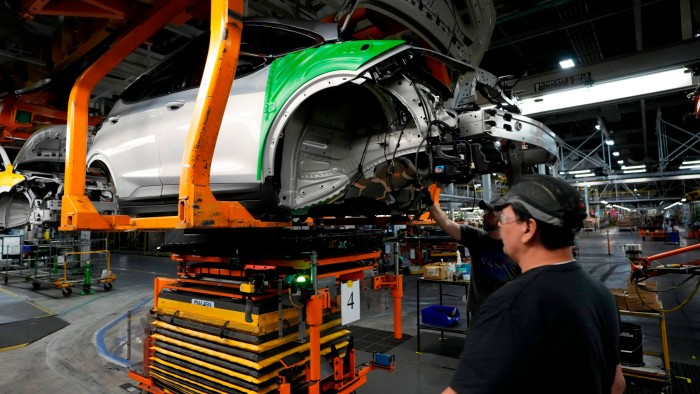In the spring of 2020, as Covid-19 was spreading across the world, General Motors chief executive Mary Barra unveiled a $20bn plan to roll out millions of affordable electric vehicles using battery supply chains sourced in North America.
Five years on, GM’s new vice-president of batteries Kurt Kelty has an even bolder ambition: for North America to “seize EV battery leadership from China” as western countries seek to break their dependence on the world’s second-largest economy for minerals and metals that are critical to powering the electric cars.
“By advancing battery technologies and driving innovation, strengthening our onshoring and making our supply chain the most competitive in the world, we’re building not just better batteries, but a stronger and more resilient US industry for the future,” Kelty told a recent conference in Washington.
The pledge for battery supremacy by the Detroit carmaker is gaining fresh urgency as Donald Trump wages a trade war with China. The two countries agreed a ceasefire that would slash respective tariffs by 115 percentage points for 90 days but risks remain over Beijing’s control over rare earth elements and magnets vital for EVs.
Both the US and Europe have for years been trying to create self-sufficient supply chains for batteries. But European start-ups have struggled to scale up production of EV batteries to compete against the likes of BYD and CATL, with Sweden’s Northvolt filing for bankruptcy in March.
More stories in this report
GM’s own battery strategy has also undergone a major overhaul under Kelty, a former Tesla executive and one of the world’s most renowned experts in the field, who was hired last year. The company in October announced its decision to drop its Ultium battery platform in favour of a greater variety of battery cell packs, including lithium iron phosphate batteries.
The group also added South Korea’s Samsung SDI to its roster of suppliers in a pivot from its focus on a partnership with LG Energy Solution, the world’s largest non-Chinese producer of EV batteries.
GM and LG have plants running in Ohio and Tennessee, producing nickel-rich, pouch-shaped batteries, while GM is also building a $3.5bn plant in Indiana with Samsung SDI to make prismatic-shaped cells from 2027. GM also expanded its partnership with LG to produce the prismatic types — which analysts say will help it improve the performance of its batteries while cutting costs.
“We’re the largest producer of battery cells in North America right now,” says Kelty. “We’re [also] the lowest cost producers in North America.”
The cost reductions come on the back of growing sales of electric cars. GM’s share of the EV market in the US reached 10 per cent after first-quarter EV sales jumped 94 per cent from a year earlier with the launch of the all-electric Chevrolet Equinox — its most affordable offering, with a starting price of $27,500 with tax credits.
GM aims to cut battery costs further by accelerating adoption of cheaper lithium iron phosphate (LFP) batteries, as opposed to the more expensive high performance nickel-rich batteries in which South Korean battery producers specialise.
According to Kelty, GM expects to reduce its combined battery cell and pack costs by $30 per kilowatt-hour this year.
“We can drop the price on our Silverado [electric pick-up truck] about $6,000 by implementing LFP in a prismatic form factor,” he says.
The LFP sector has traditionally been dominated by Chinese battery producers CATL and BYD, and analysts say building a non-Chinese supply chain for these batteries will be one of the biggest challenges for GM.
Tesla imports battery materials from China, and Ford is building a factory in Michigan that will manufacture LFP batteries using CATL’s technology.
South Korean battery makers are also rushing to produce LFP batteries, but GM has yet to spell out where it will source its LFP batteries from and how it will locally produce them.
Kelty declined to comment on a previous media report that GM is in talks with Japan’s TDK to source LFP batteries produced under a potential licensing deal with CATL.
“What we can say is that we’re localising as fast as we possibly can,” Kelty says. He did not rule out working with Chinese partners but added: “When you look at cost, you also have to include tariffs. You can’t ignore those.”
Tim Bush, a battery analyst at UBS, says it is unclear whether US companies will be able to enter direct or indirect licensing deals with Chinese battery makers in the current political environment. “Alternatively, GM could wait for a new . . . non-Chinese LFP supply chain to be built, but it’s not clear how long this will take,” he adds.
Kelty acknowledges that the biggest hurdle to localising LFP battery production will be the sourcing of cathode materials, an essential and expensive part of an EV battery that is currently produced mostly in China.
GM is working with its cell manufacturing partners as well as US start-ups to build a domestic supply chain. In January, it also signed a deal with Norway’s Vianode to secure long-term supply of anode graphite, the largest component of a lithium ion battery by weight.
Watch the FT Future of the Car summit
May’s London conference featured senior industry figures and FT journalists. Pay to view video of all sessions at car.live.ft.com
A self-described “battery geek”, Kelty says GM is also working to develop other battery materials. Last week, the carmaker and LG Energy Solution said they plan to begin commercial production of lithium manganese-rich prismatic battery cells in the US by 2028.
Manganese is considered more affordable than other battery materials such as cobalt, while delivering higher energy density.
“There’s a lot of incremental advances that we’re excited about making. And the bigger ones, the new cathodes, the new anodes, those are ones that are exciting,” Kelty says.
Additional reporting by Claire Bushey in Chicago
